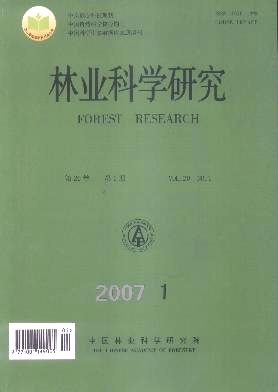|
[1]
|
支济伟, 陈益泰, 李恭学. 以龙15为共同母本的杉木杂交后代的变异和选择[A] . 见: 中国林科院亚热带林业研究所. 浙江省 八五!攻关专题研究报告: 杉木材性遗传变异和改良策略研究
|
|
[R] . 中国林科院亚热带林业研究所, 1995: 25 ~ 31
|
|
[3]
|
齐明. 杉木双系种子园异交率的初步研究[J] . 林业科学研究,2004, 17 (专刊) : 71 ~ 77
|
|
[4]
|
葛颂. 用同工酶研究马尾松群体的遗传结构[D]. 南京: 南京林业大学, 1986
|
|
[5]
|
张维强, 唐秀芝. 同工酶与植物遗传育种[M] . 北京: 北京农业大学出版社, 1993: 140~ 189
|
|
[6]
|
王启和, 托马斯# 格布雷克. 杉木9个酶系统同工酶位点的遗传和连锁[J] . 四川林业科技, 1992, 13 ( 3) : 1~ 8
|
|
[7]
|
施季森, 叶志宏. 杉木遗传多态性与多基因位点遗传结构[J] . 南京林业大学学报, 1993, 17 ( 3) : 9~ 14
|
|
[8]
|
赖焕林. 马尾松交配系统研究[D] . 南京: 南京林业大学, 1998
|
|
[9]
|
王明庥, 黄敏仁. 用同工酶分析法鉴定黑杨派无性系[J] . 南京林产工业学院学报, 1982( 1) : 105~ 111
|
|
[10]
|
黄敏仁, 陈道明. 杂种马褂木的同工酶分析[J] . 南京林产工业学院学报, 1979 ( 1 /2) : 156 ~ 158
|
|
[11]
|
Aradhya K M , Ph ill ipsV D. Lack of association betw een allozym eheterozygosity and juven ile traits in Eucalyptus [J]. N ew Forests,1995, 9( 2) : 97~ 110 |
|
[12]
|
Arcade A, Favire-Ram pan t P, Legu erroue B, et al. H eterozygos ityand hybrid perform ance in larch [J] . Theoretical and App lied G enetics, 1996, 93 ( 8) : 1274 ~ 1281 |
|
[13]
|
B ritten H B. M eta-an alyses of the associat ion b etw een mu lt ilocush eterozygosity and f itness [J] . E volut ion, 1996, 50 ( 6 ): 2158~ 2164 |
|
[14]
|
Bu sh R M, Sm ouse P E, Led ig F T . The fitness consequences ofm u ltip le-locus heterozygos ity: the relat ion sh ip b etw een heterozygosity and grow th rate in p itch p ine[J]. E volu tion, 1987, 41( 4) : 787~ 798 |
|
[15]
|
Gov indaraju D R, Dan cik B P . Relationsh ip betw een allozym e heterozygos ity and b iom ass p roduction in jack p ine under d ifferen t environm ental cond it ion s[J] . H ered ity, 1986, 57( 2) : 145~ 148 |
|
[16]
|
Know les P, Grant M C. Genet ic pattern s associated w ith grow thvariab ility in ponderosa p in e[J]. Am erican Jou rnal of B otany ,1981, 68 ( 7) : 942 ~ 946 |
|
[17]
|
M it ton J B, S chu sterW S F, C oth ran E G, et al. Correlat ion b etw een the individual h eterozygosity of parents and their offspring[J]. H eredity, 1993, 71( 1 ): 59~ 63 |
|
[18]
|
M itton J B, Know les P, S tu rgeon K B, e t a l. Associat ion s betweenh eterozygos ity and grow th rate variab les in three w es tern forest trees[A]. In: Conk leM T. Proceedings of the symposium on isozym es ofNorth Am erican forest trees and forest insects[C] . B erkeley: PacificSouthw est Forest and Range Exp erim ent S tat ion, 1979: 27~ 34 |
|
[19]
|
Savo lain en O , H ed rick P. H eterozygosity and fitness: no associat ion in scots p ine[J] . Gen et ics, 1995, 140( 2 ): 755~ 842 |
|
[20]
|
Strauss S H. H eterozygosity and developm ental stab ility am ong inb red and crossb red trees of knob cone pine [J] . Evo lut ion, 1987, 41( 2) : 331 ~ 339 |
|
[21]
|
李悦. 油松育种系统遗传多样性研究[J] . 北京林业大学学报,2000, 22( 1 ): 12~ 19
|
|
[22]
|
Schm idtl ing R C, C arroll E, LaFarge T. A llozym e d ivers ity of selected and natu ral lob lolly p in e popu lat ions [J]. S ilvae Genetica ,1999, 48( 1 ): 35~ 45 |
|
[23]
|
E l-Kassaby Y A, S zik la iO. Genet ic variat ion of allozym e and qu ant itative traits in a selected Douglas-fir ( P seud otsuga m enziesii var.m enziesii (M irb. ) F ranco ) popu lat ion [J] . Forest E cology andM anagem ent , 1982, 4( 2) : 115~ 126 |
|
[24]
|
Ch aisurisriK , E l-Kassaby Y A. G enetic d iversity in a seed produ ct ion popu lation vs natural popu lat ion s of S itka sprue[J]. B iod ivers ity and C onservat ion, 1994, 3 ( 6) : 512 ~ 523 |
|
[25]
|
God tM JW, H am rick J L, Edw ards-Bu rkeM A, et al. C omparisonof genetic d ivers ity in w h ite spruce ( P icea g lauca ) and jack p ine(P inu s banksiana ) seed orchardsw ith natu ral popu lat ion s[J] . C an ad ian Journ al of Forest Research, 2001, 31( 6) : 943~ 949 |
|
[26]
|
Konnert V M. Comparison of the gen et ic structu re of d ifferent gen??erat ion s natu rally regenerated spru ce stands in the B lack Forest[J]. S ilvae G enetica, 1991, 40 ( 2) : 60~ 65 |





 DownLoad:
DownLoad: